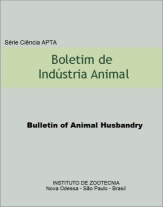Performance of weaned piglets fed diets containing spray dried plasma
DOI:
https://doi.org/10.17523/bia.v73n2p127Keywords:
alternative feeds, early phase, feeding management, post-weaning.Abstract
The objective of this study was to evaluate the effect of spray dried plasma (SDP) on the performance and incidence of diarrhea in early weaned piglets. Fifty-six piglets from the same lineage, with an approximate live weight of 3.87 ± 0.65 kg and approximate age of 14 days, were used. Four levels of inclusion of SDP in the piglet diets were tested during two consecutive periods, 14 to 28 days of age (period 1) and 29 to 42 days of age (period 2). The levels of SDP used were 0%, 2%, 4% and 6% for period 1 and 0%, 1%, 2% and 3% for period 2. During period 3 (42 to 56 days of age), all piglets received a diet without SDP. For performance evaluation, the piglets were weighed fortnightly and on the last day of the trial when the age of the batch was 56 days. Daily feed intake, average daily weight gain, and feed conversion were analyzed. No significant difference (P<0.05) in feed intake, weight gain or feed conversion was observed between treatments. The inclusion of SDP in the diet did not influence the performance of early weaned pigletsDownloads
Downloads
Published
Issue
Section
License
Os autores não serão remunerados pela publicação de trabalhos, pois devem abrir mão de seus direitos autorais em favor deste periódico. Por outro lado, os autores ficam autorizados a publicar seus artigos, simultaneamente, em repositórios da instituição de sua origem, desde que citada a fonte da publicação original seja Boletim de Indústria Animal. A revista se reserva o direito de efetuar, nos originais, alterações de ordem normativa, ortográfica e gramatical, com vistas a manter o padrão culto da língua e a credibilidade do veículo. Respeitará, no entanto, o estilo de escrever dos autores. Alterações, correções ou sugestões de ordem conceitual serão encaminhadas aos autores, quando necessário. Nesses casos, os artigos, depois de adequados, deverão ser submetidos a nova apreciação. As opiniões emitidas pelos autores dos artigos são de sua exclusiva responsabilidade. Todo o conteúdo deste periódico, exceto onde está identificado, está licenciado sob a Licença Creative Commons Attribution (CC-BY-NC). A condição BY implica que os licenciados podem copiar, distribuir, exibir e executar a obra e fazer trabalhos derivados com base em que só se dão o autor ou licenciante os créditos na forma especificada por estes. A cláusula NC significa que os licenciados podem copiar, distribuir, exibir e executar a obra e fazer trabalhos derivados com base apenas para fins não comerciais.













